AHS 2019: Aged Care Industry Workforce and Healthcare Reforms
VerifiedAdded on 2023/02/01
|14
|4251
|51
Report
AI Summary
This report provides an in-depth analysis of the aged care industry in Australia, highlighting the increasing demand for aged care services due to an aging population and advancements in medical research. It examines the challenges within the healthcare workforce, including skill mix deficiencies among staff and a shortage of applicants. The report emphasizes the need for a skilled and adaptable workforce, covering clinical, pharmacological, and soft skills, as well as technological and cultural competency. It discusses the importance of capacity building and skill mix in developing a better workforce. The report also proposes healthcare reforms, including HR initiatives like fostering a caring culture, and collaboration among service providers, educational institutions, and the government to address skill gaps. The report references key studies and reports, providing a comprehensive overview of the current state and future needs of the aged care industry.
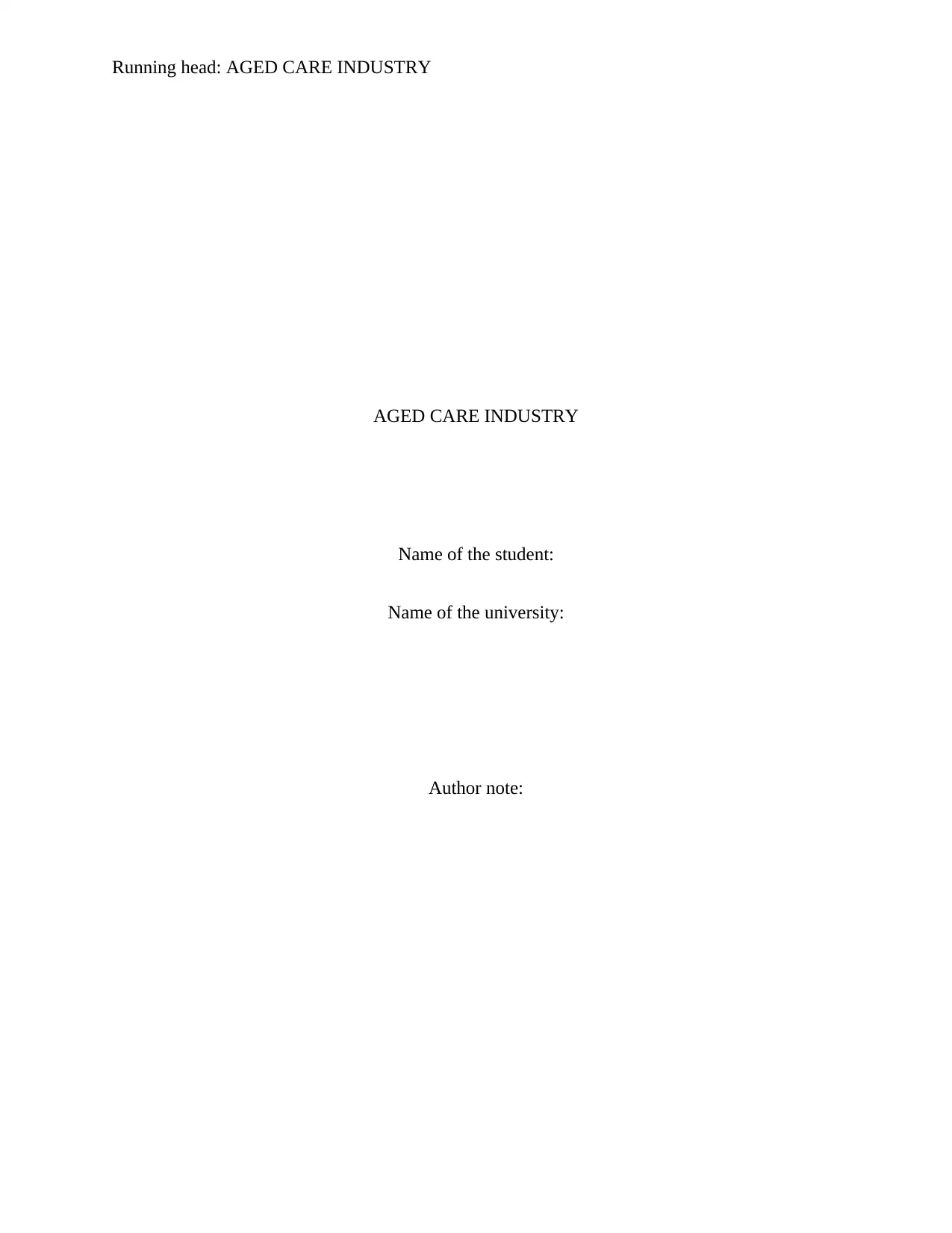
Running head: AGED CARE INDUSTRY
AGED CARE INDUSTRY
Name of the student:
Name of the university:
Author note:
AGED CARE INDUSTRY
Name of the student:
Name of the university:
Author note:
Paraphrase This Document
Need a fresh take? Get an instant paraphrase of this document with our AI Paraphraser
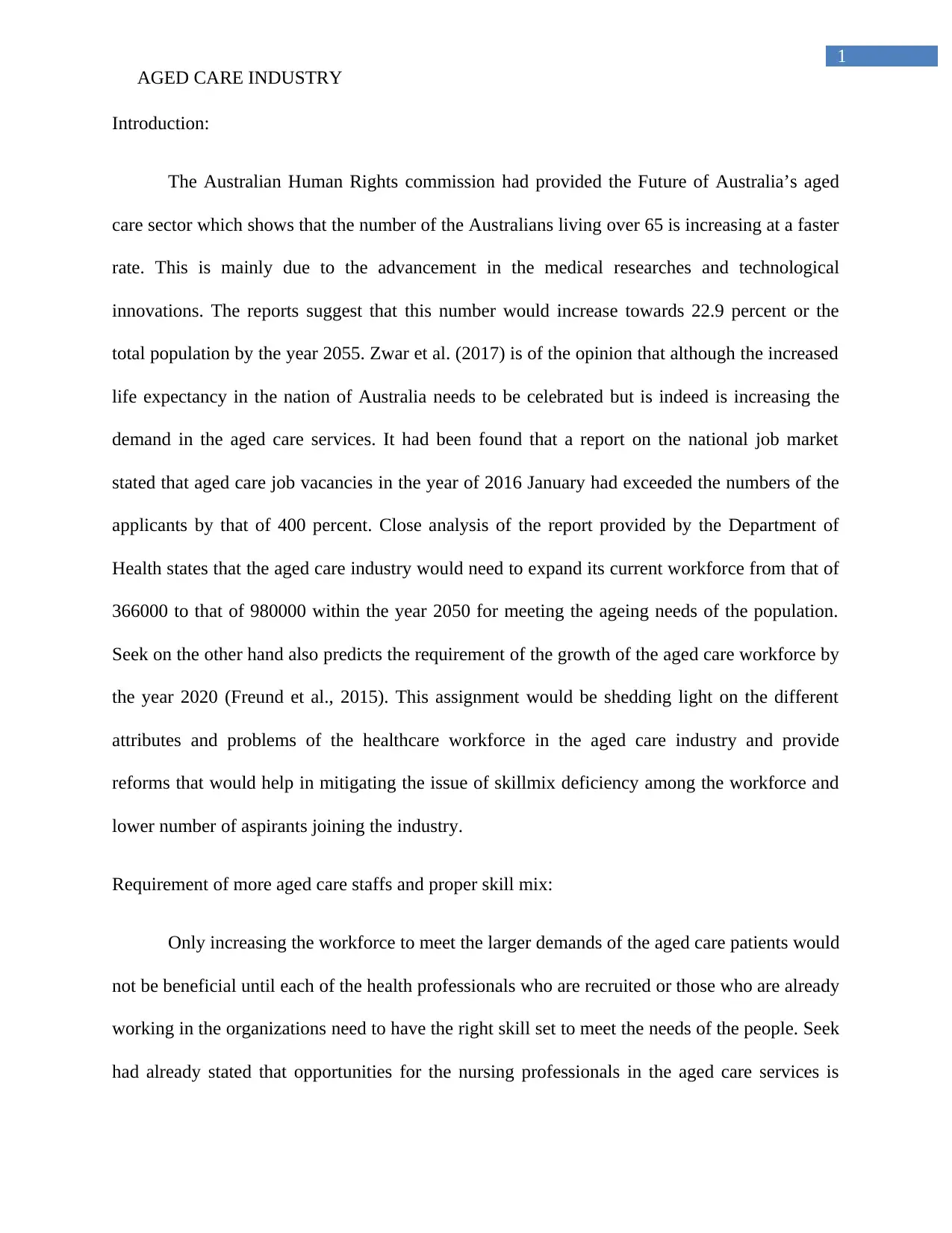
1
AGED CARE INDUSTRY
Introduction:
The Australian Human Rights commission had provided the Future of Australia’s aged
care sector which shows that the number of the Australians living over 65 is increasing at a faster
rate. This is mainly due to the advancement in the medical researches and technological
innovations. The reports suggest that this number would increase towards 22.9 percent or the
total population by the year 2055. Zwar et al. (2017) is of the opinion that although the increased
life expectancy in the nation of Australia needs to be celebrated but is indeed is increasing the
demand in the aged care services. It had been found that a report on the national job market
stated that aged care job vacancies in the year of 2016 January had exceeded the numbers of the
applicants by that of 400 percent. Close analysis of the report provided by the Department of
Health states that the aged care industry would need to expand its current workforce from that of
366000 to that of 980000 within the year 2050 for meeting the ageing needs of the population.
Seek on the other hand also predicts the requirement of the growth of the aged care workforce by
the year 2020 (Freund et al., 2015). This assignment would be shedding light on the different
attributes and problems of the healthcare workforce in the aged care industry and provide
reforms that would help in mitigating the issue of skillmix deficiency among the workforce and
lower number of aspirants joining the industry.
Requirement of more aged care staffs and proper skill mix:
Only increasing the workforce to meet the larger demands of the aged care patients would
not be beneficial until each of the health professionals who are recruited or those who are already
working in the organizations need to have the right skill set to meet the needs of the people. Seek
had already stated that opportunities for the nursing professionals in the aged care services is
AGED CARE INDUSTRY
Introduction:
The Australian Human Rights commission had provided the Future of Australia’s aged
care sector which shows that the number of the Australians living over 65 is increasing at a faster
rate. This is mainly due to the advancement in the medical researches and technological
innovations. The reports suggest that this number would increase towards 22.9 percent or the
total population by the year 2055. Zwar et al. (2017) is of the opinion that although the increased
life expectancy in the nation of Australia needs to be celebrated but is indeed is increasing the
demand in the aged care services. It had been found that a report on the national job market
stated that aged care job vacancies in the year of 2016 January had exceeded the numbers of the
applicants by that of 400 percent. Close analysis of the report provided by the Department of
Health states that the aged care industry would need to expand its current workforce from that of
366000 to that of 980000 within the year 2050 for meeting the ageing needs of the population.
Seek on the other hand also predicts the requirement of the growth of the aged care workforce by
the year 2020 (Freund et al., 2015). This assignment would be shedding light on the different
attributes and problems of the healthcare workforce in the aged care industry and provide
reforms that would help in mitigating the issue of skillmix deficiency among the workforce and
lower number of aspirants joining the industry.
Requirement of more aged care staffs and proper skill mix:
Only increasing the workforce to meet the larger demands of the aged care patients would
not be beneficial until each of the health professionals who are recruited or those who are already
working in the organizations need to have the right skill set to meet the needs of the people. Seek
had already stated that opportunities for the nursing professionals in the aged care services is
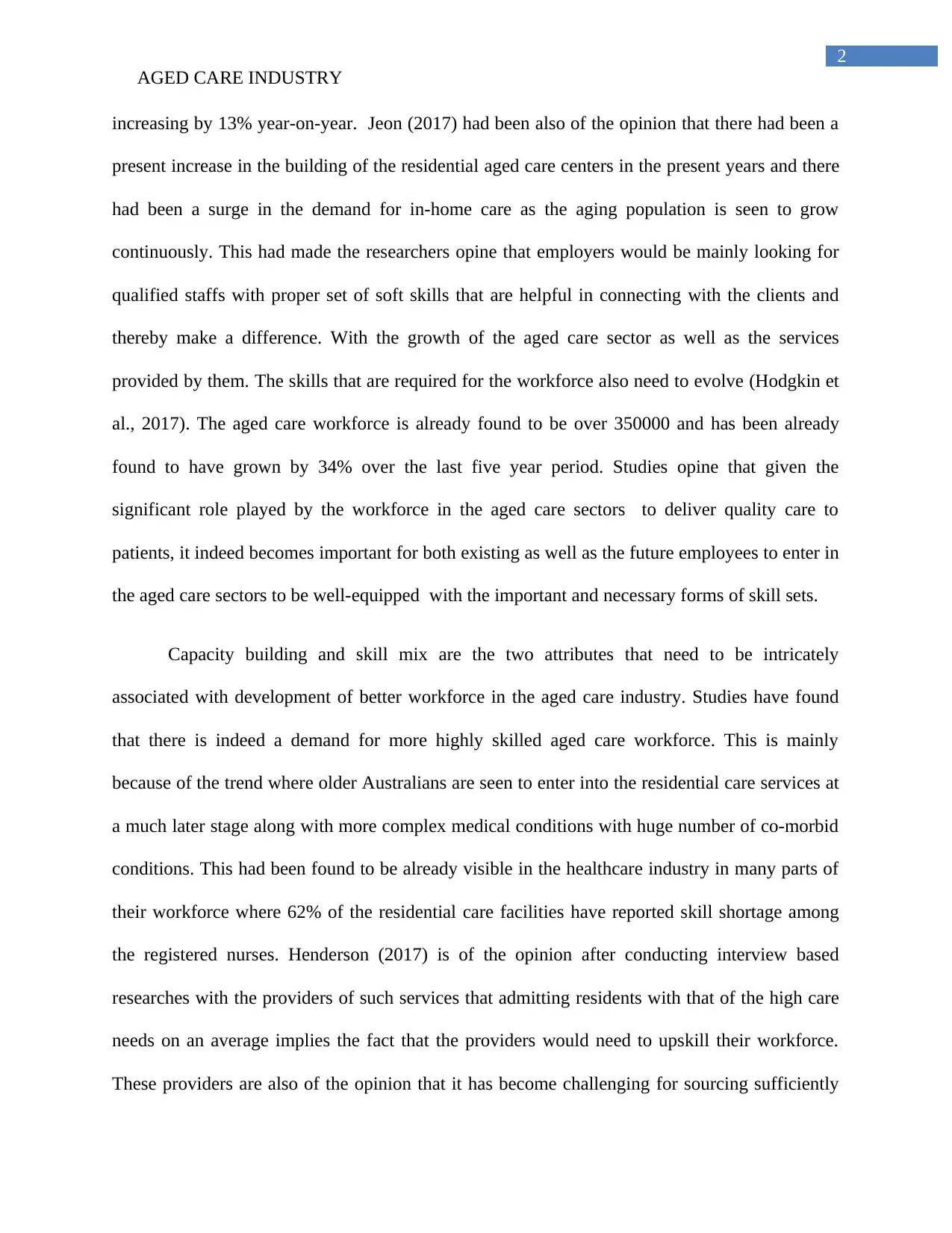
2
AGED CARE INDUSTRY
increasing by 13% year-on-year. Jeon (2017) had been also of the opinion that there had been a
present increase in the building of the residential aged care centers in the present years and there
had been a surge in the demand for in-home care as the aging population is seen to grow
continuously. This had made the researchers opine that employers would be mainly looking for
qualified staffs with proper set of soft skills that are helpful in connecting with the clients and
thereby make a difference. With the growth of the aged care sector as well as the services
provided by them. The skills that are required for the workforce also need to evolve (Hodgkin et
al., 2017). The aged care workforce is already found to be over 350000 and has been already
found to have grown by 34% over the last five year period. Studies opine that given the
significant role played by the workforce in the aged care sectors to deliver quality care to
patients, it indeed becomes important for both existing as well as the future employees to enter in
the aged care sectors to be well-equipped with the important and necessary forms of skill sets.
Capacity building and skill mix are the two attributes that need to be intricately
associated with development of better workforce in the aged care industry. Studies have found
that there is indeed a demand for more highly skilled aged care workforce. This is mainly
because of the trend where older Australians are seen to enter into the residential care services at
a much later stage along with more complex medical conditions with huge number of co-morbid
conditions. This had been found to be already visible in the healthcare industry in many parts of
their workforce where 62% of the residential care facilities have reported skill shortage among
the registered nurses. Henderson (2017) is of the opinion after conducting interview based
researches with the providers of such services that admitting residents with that of the high care
needs on an average implies the fact that the providers would need to upskill their workforce.
These providers are also of the opinion that it has become challenging for sourcing sufficiently
AGED CARE INDUSTRY
increasing by 13% year-on-year. Jeon (2017) had been also of the opinion that there had been a
present increase in the building of the residential aged care centers in the present years and there
had been a surge in the demand for in-home care as the aging population is seen to grow
continuously. This had made the researchers opine that employers would be mainly looking for
qualified staffs with proper set of soft skills that are helpful in connecting with the clients and
thereby make a difference. With the growth of the aged care sector as well as the services
provided by them. The skills that are required for the workforce also need to evolve (Hodgkin et
al., 2017). The aged care workforce is already found to be over 350000 and has been already
found to have grown by 34% over the last five year period. Studies opine that given the
significant role played by the workforce in the aged care sectors to deliver quality care to
patients, it indeed becomes important for both existing as well as the future employees to enter in
the aged care sectors to be well-equipped with the important and necessary forms of skill sets.
Capacity building and skill mix are the two attributes that need to be intricately
associated with development of better workforce in the aged care industry. Studies have found
that there is indeed a demand for more highly skilled aged care workforce. This is mainly
because of the trend where older Australians are seen to enter into the residential care services at
a much later stage along with more complex medical conditions with huge number of co-morbid
conditions. This had been found to be already visible in the healthcare industry in many parts of
their workforce where 62% of the residential care facilities have reported skill shortage among
the registered nurses. Henderson (2017) is of the opinion after conducting interview based
researches with the providers of such services that admitting residents with that of the high care
needs on an average implies the fact that the providers would need to upskill their workforce.
These providers are also of the opinion that it has become challenging for sourcing sufficiently
⊘ This is a preview!⊘
Do you want full access?
Subscribe today to unlock all pages.

Trusted by 1+ million students worldwide
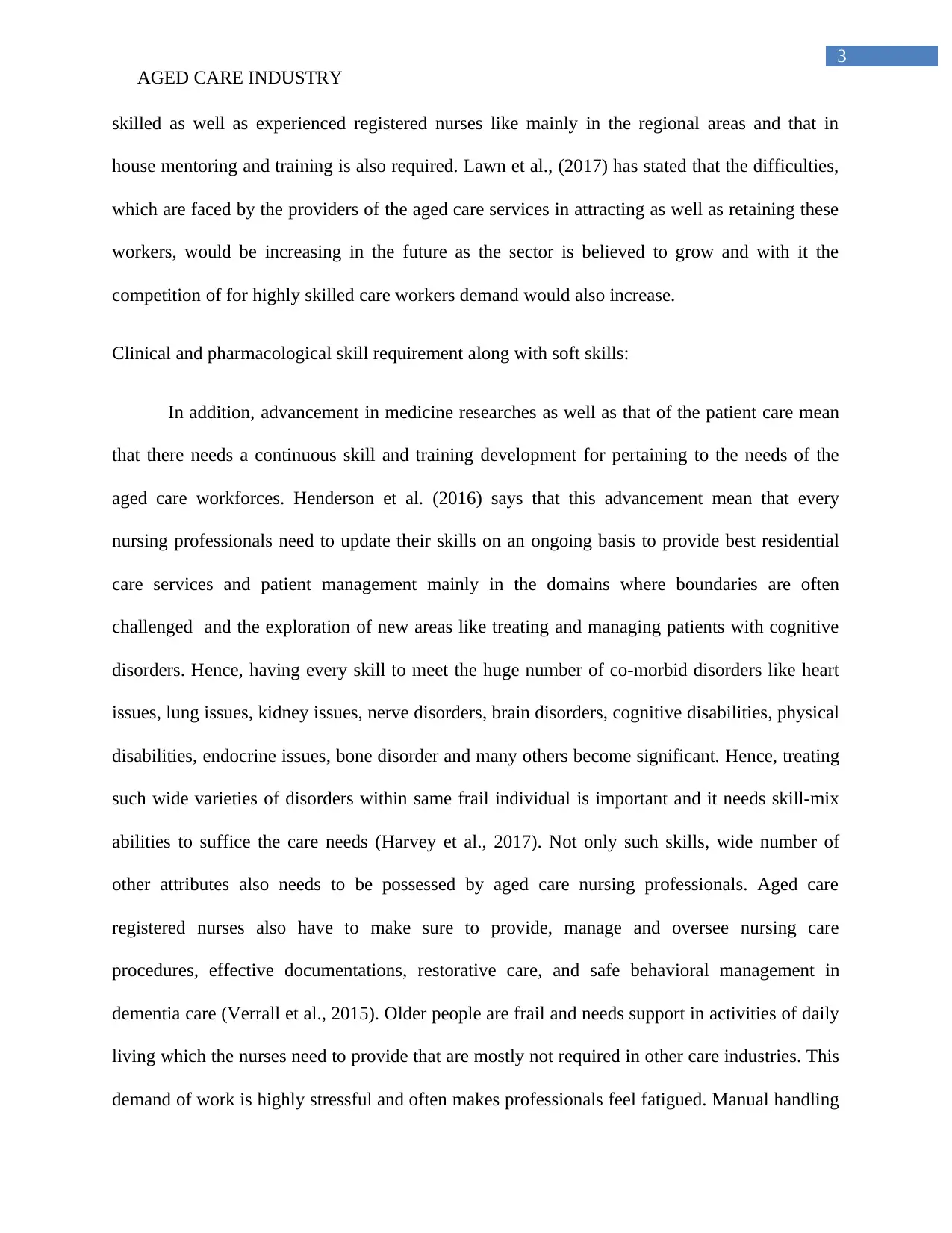
3
AGED CARE INDUSTRY
skilled as well as experienced registered nurses like mainly in the regional areas and that in
house mentoring and training is also required. Lawn et al., (2017) has stated that the difficulties,
which are faced by the providers of the aged care services in attracting as well as retaining these
workers, would be increasing in the future as the sector is believed to grow and with it the
competition of for highly skilled care workers demand would also increase.
Clinical and pharmacological skill requirement along with soft skills:
In addition, advancement in medicine researches as well as that of the patient care mean
that there needs a continuous skill and training development for pertaining to the needs of the
aged care workforces. Henderson et al. (2016) says that this advancement mean that every
nursing professionals need to update their skills on an ongoing basis to provide best residential
care services and patient management mainly in the domains where boundaries are often
challenged and the exploration of new areas like treating and managing patients with cognitive
disorders. Hence, having every skill to meet the huge number of co-morbid disorders like heart
issues, lung issues, kidney issues, nerve disorders, brain disorders, cognitive disabilities, physical
disabilities, endocrine issues, bone disorder and many others become significant. Hence, treating
such wide varieties of disorders within same frail individual is important and it needs skill-mix
abilities to suffice the care needs (Harvey et al., 2017). Not only such skills, wide number of
other attributes also needs to be possessed by aged care nursing professionals. Aged care
registered nurses also have to make sure to provide, manage and oversee nursing care
procedures, effective documentations, restorative care, and safe behavioral management in
dementia care (Verrall et al., 2015). Older people are frail and needs support in activities of daily
living which the nurses need to provide that are mostly not required in other care industries. This
demand of work is highly stressful and often makes professionals feel fatigued. Manual handling
AGED CARE INDUSTRY
skilled as well as experienced registered nurses like mainly in the regional areas and that in
house mentoring and training is also required. Lawn et al., (2017) has stated that the difficulties,
which are faced by the providers of the aged care services in attracting as well as retaining these
workers, would be increasing in the future as the sector is believed to grow and with it the
competition of for highly skilled care workers demand would also increase.
Clinical and pharmacological skill requirement along with soft skills:
In addition, advancement in medicine researches as well as that of the patient care mean
that there needs a continuous skill and training development for pertaining to the needs of the
aged care workforces. Henderson et al. (2016) says that this advancement mean that every
nursing professionals need to update their skills on an ongoing basis to provide best residential
care services and patient management mainly in the domains where boundaries are often
challenged and the exploration of new areas like treating and managing patients with cognitive
disorders. Hence, having every skill to meet the huge number of co-morbid disorders like heart
issues, lung issues, kidney issues, nerve disorders, brain disorders, cognitive disabilities, physical
disabilities, endocrine issues, bone disorder and many others become significant. Hence, treating
such wide varieties of disorders within same frail individual is important and it needs skill-mix
abilities to suffice the care needs (Harvey et al., 2017). Not only such skills, wide number of
other attributes also needs to be possessed by aged care nursing professionals. Aged care
registered nurses also have to make sure to provide, manage and oversee nursing care
procedures, effective documentations, restorative care, and safe behavioral management in
dementia care (Verrall et al., 2015). Older people are frail and needs support in activities of daily
living which the nurses need to provide that are mostly not required in other care industries. This
demand of work is highly stressful and often makes professionals feel fatigued. Manual handling
Paraphrase This Document
Need a fresh take? Get an instant paraphrase of this document with our AI Paraphraser
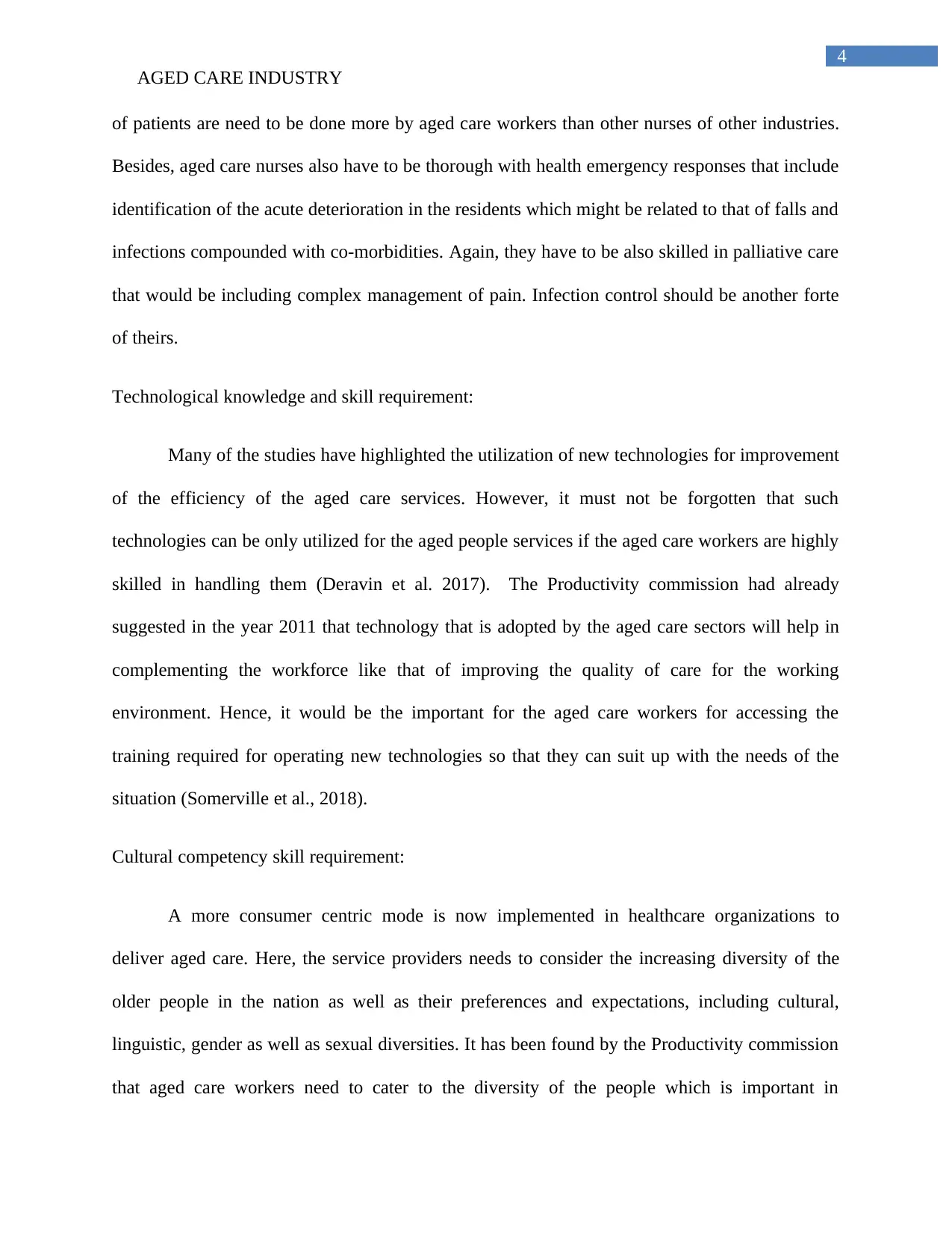
4
AGED CARE INDUSTRY
of patients are need to be done more by aged care workers than other nurses of other industries.
Besides, aged care nurses also have to be thorough with health emergency responses that include
identification of the acute deterioration in the residents which might be related to that of falls and
infections compounded with co-morbidities. Again, they have to be also skilled in palliative care
that would be including complex management of pain. Infection control should be another forte
of theirs.
Technological knowledge and skill requirement:
Many of the studies have highlighted the utilization of new technologies for improvement
of the efficiency of the aged care services. However, it must not be forgotten that such
technologies can be only utilized for the aged people services if the aged care workers are highly
skilled in handling them (Deravin et al. 2017). The Productivity commission had already
suggested in the year 2011 that technology that is adopted by the aged care sectors will help in
complementing the workforce like that of improving the quality of care for the working
environment. Hence, it would be the important for the aged care workers for accessing the
training required for operating new technologies so that they can suit up with the needs of the
situation (Somerville et al., 2018).
Cultural competency skill requirement:
A more consumer centric mode is now implemented in healthcare organizations to
deliver aged care. Here, the service providers needs to consider the increasing diversity of the
older people in the nation as well as their preferences and expectations, including cultural,
linguistic, gender as well as sexual diversities. It has been found by the Productivity commission
that aged care workers need to cater to the diversity of the people which is important in
AGED CARE INDUSTRY
of patients are need to be done more by aged care workers than other nurses of other industries.
Besides, aged care nurses also have to be thorough with health emergency responses that include
identification of the acute deterioration in the residents which might be related to that of falls and
infections compounded with co-morbidities. Again, they have to be also skilled in palliative care
that would be including complex management of pain. Infection control should be another forte
of theirs.
Technological knowledge and skill requirement:
Many of the studies have highlighted the utilization of new technologies for improvement
of the efficiency of the aged care services. However, it must not be forgotten that such
technologies can be only utilized for the aged people services if the aged care workers are highly
skilled in handling them (Deravin et al. 2017). The Productivity commission had already
suggested in the year 2011 that technology that is adopted by the aged care sectors will help in
complementing the workforce like that of improving the quality of care for the working
environment. Hence, it would be the important for the aged care workers for accessing the
training required for operating new technologies so that they can suit up with the needs of the
situation (Somerville et al., 2018).
Cultural competency skill requirement:
A more consumer centric mode is now implemented in healthcare organizations to
deliver aged care. Here, the service providers needs to consider the increasing diversity of the
older people in the nation as well as their preferences and expectations, including cultural,
linguistic, gender as well as sexual diversities. It has been found by the Productivity commission
that aged care workers need to cater to the diversity of the people which is important in
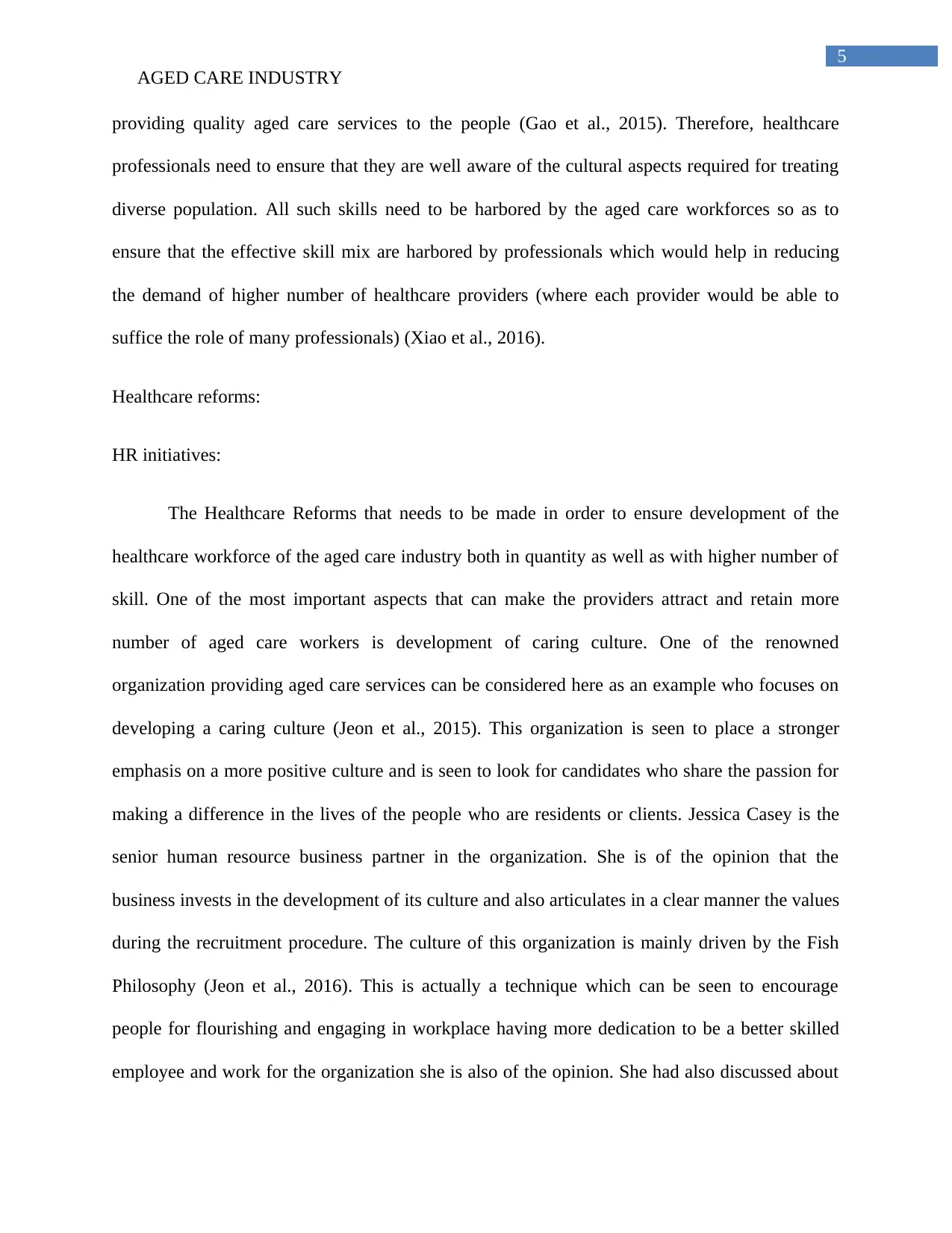
5
AGED CARE INDUSTRY
providing quality aged care services to the people (Gao et al., 2015). Therefore, healthcare
professionals need to ensure that they are well aware of the cultural aspects required for treating
diverse population. All such skills need to be harbored by the aged care workforces so as to
ensure that the effective skill mix are harbored by professionals which would help in reducing
the demand of higher number of healthcare providers (where each provider would be able to
suffice the role of many professionals) (Xiao et al., 2016).
Healthcare reforms:
HR initiatives:
The Healthcare Reforms that needs to be made in order to ensure development of the
healthcare workforce of the aged care industry both in quantity as well as with higher number of
skill. One of the most important aspects that can make the providers attract and retain more
number of aged care workers is development of caring culture. One of the renowned
organization providing aged care services can be considered here as an example who focuses on
developing a caring culture (Jeon et al., 2015). This organization is seen to place a stronger
emphasis on a more positive culture and is seen to look for candidates who share the passion for
making a difference in the lives of the people who are residents or clients. Jessica Casey is the
senior human resource business partner in the organization. She is of the opinion that the
business invests in the development of its culture and also articulates in a clear manner the values
during the recruitment procedure. The culture of this organization is mainly driven by the Fish
Philosophy (Jeon et al., 2016). This is actually a technique which can be seen to encourage
people for flourishing and engaging in workplace having more dedication to be a better skilled
employee and work for the organization she is also of the opinion. She had also discussed about
AGED CARE INDUSTRY
providing quality aged care services to the people (Gao et al., 2015). Therefore, healthcare
professionals need to ensure that they are well aware of the cultural aspects required for treating
diverse population. All such skills need to be harbored by the aged care workforces so as to
ensure that the effective skill mix are harbored by professionals which would help in reducing
the demand of higher number of healthcare providers (where each provider would be able to
suffice the role of many professionals) (Xiao et al., 2016).
Healthcare reforms:
HR initiatives:
The Healthcare Reforms that needs to be made in order to ensure development of the
healthcare workforce of the aged care industry both in quantity as well as with higher number of
skill. One of the most important aspects that can make the providers attract and retain more
number of aged care workers is development of caring culture. One of the renowned
organization providing aged care services can be considered here as an example who focuses on
developing a caring culture (Jeon et al., 2015). This organization is seen to place a stronger
emphasis on a more positive culture and is seen to look for candidates who share the passion for
making a difference in the lives of the people who are residents or clients. Jessica Casey is the
senior human resource business partner in the organization. She is of the opinion that the
business invests in the development of its culture and also articulates in a clear manner the values
during the recruitment procedure. The culture of this organization is mainly driven by the Fish
Philosophy (Jeon et al., 2016). This is actually a technique which can be seen to encourage
people for flourishing and engaging in workplace having more dedication to be a better skilled
employee and work for the organization she is also of the opinion. She had also discussed about
⊘ This is a preview!⊘
Do you want full access?
Subscribe today to unlock all pages.

Trusted by 1+ million students worldwide
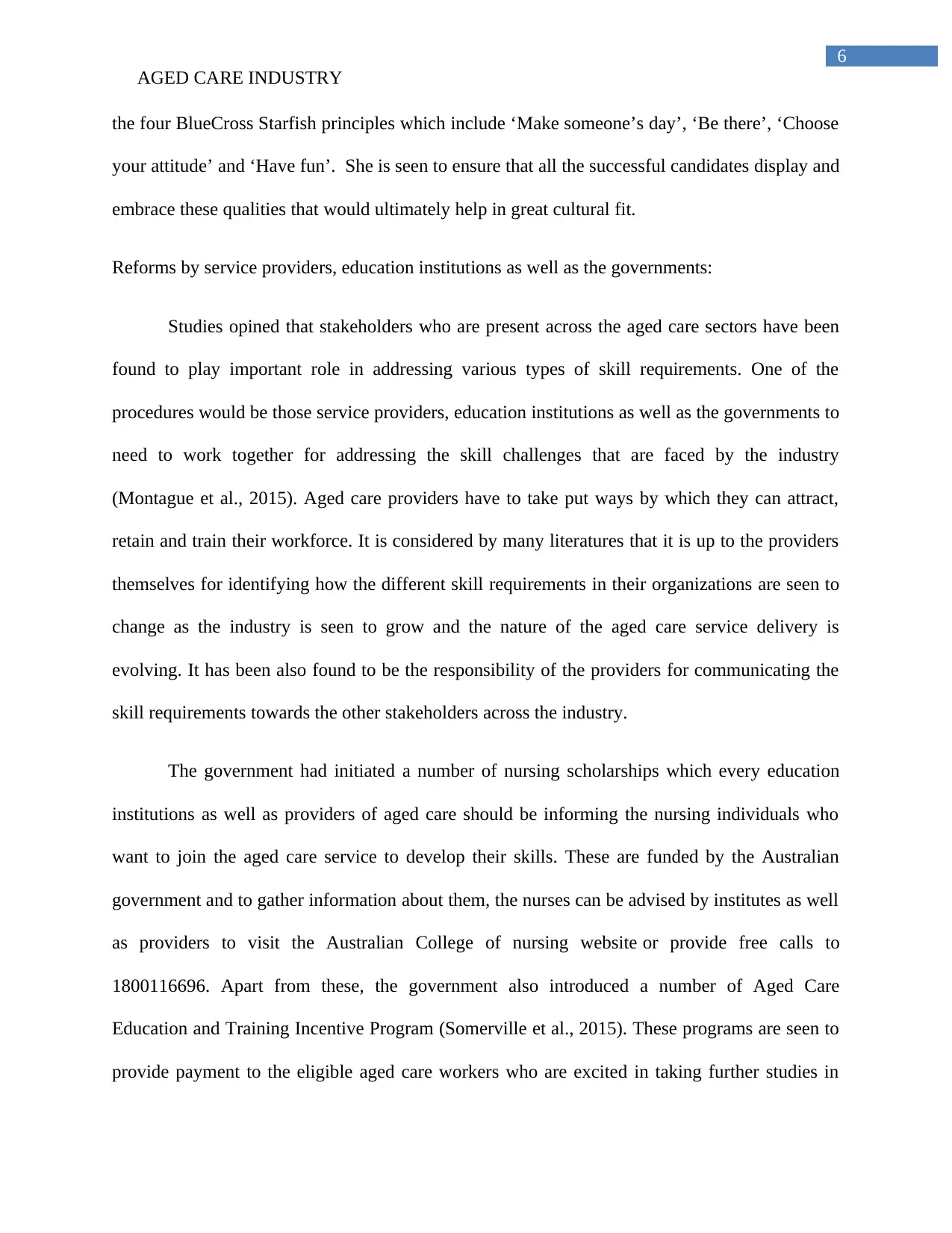
6
AGED CARE INDUSTRY
the four BlueCross Starfish principles which include ‘Make someone’s day’, ‘Be there’, ‘Choose
your attitude’ and ‘Have fun’. She is seen to ensure that all the successful candidates display and
embrace these qualities that would ultimately help in great cultural fit.
Reforms by service providers, education institutions as well as the governments:
Studies opined that stakeholders who are present across the aged care sectors have been
found to play important role in addressing various types of skill requirements. One of the
procedures would be those service providers, education institutions as well as the governments to
need to work together for addressing the skill challenges that are faced by the industry
(Montague et al., 2015). Aged care providers have to take put ways by which they can attract,
retain and train their workforce. It is considered by many literatures that it is up to the providers
themselves for identifying how the different skill requirements in their organizations are seen to
change as the industry is seen to grow and the nature of the aged care service delivery is
evolving. It has been also found to be the responsibility of the providers for communicating the
skill requirements towards the other stakeholders across the industry.
The government had initiated a number of nursing scholarships which every education
institutions as well as providers of aged care should be informing the nursing individuals who
want to join the aged care service to develop their skills. These are funded by the Australian
government and to gather information about them, the nurses can be advised by institutes as well
as providers to visit the Australian College of nursing website or provide free calls to
1800116696. Apart from these, the government also introduced a number of Aged Care
Education and Training Incentive Program (Somerville et al., 2015). These programs are seen to
provide payment to the eligible aged care workers who are excited in taking further studies in
AGED CARE INDUSTRY
the four BlueCross Starfish principles which include ‘Make someone’s day’, ‘Be there’, ‘Choose
your attitude’ and ‘Have fun’. She is seen to ensure that all the successful candidates display and
embrace these qualities that would ultimately help in great cultural fit.
Reforms by service providers, education institutions as well as the governments:
Studies opined that stakeholders who are present across the aged care sectors have been
found to play important role in addressing various types of skill requirements. One of the
procedures would be those service providers, education institutions as well as the governments to
need to work together for addressing the skill challenges that are faced by the industry
(Montague et al., 2015). Aged care providers have to take put ways by which they can attract,
retain and train their workforce. It is considered by many literatures that it is up to the providers
themselves for identifying how the different skill requirements in their organizations are seen to
change as the industry is seen to grow and the nature of the aged care service delivery is
evolving. It has been also found to be the responsibility of the providers for communicating the
skill requirements towards the other stakeholders across the industry.
The government had initiated a number of nursing scholarships which every education
institutions as well as providers of aged care should be informing the nursing individuals who
want to join the aged care service to develop their skills. These are funded by the Australian
government and to gather information about them, the nurses can be advised by institutes as well
as providers to visit the Australian College of nursing website or provide free calls to
1800116696. Apart from these, the government also introduced a number of Aged Care
Education and Training Incentive Program (Somerville et al., 2015). These programs are seen to
provide payment to the eligible aged care workers who are excited in taking further studies in
Paraphrase This Document
Need a fresh take? Get an instant paraphrase of this document with our AI Paraphraser
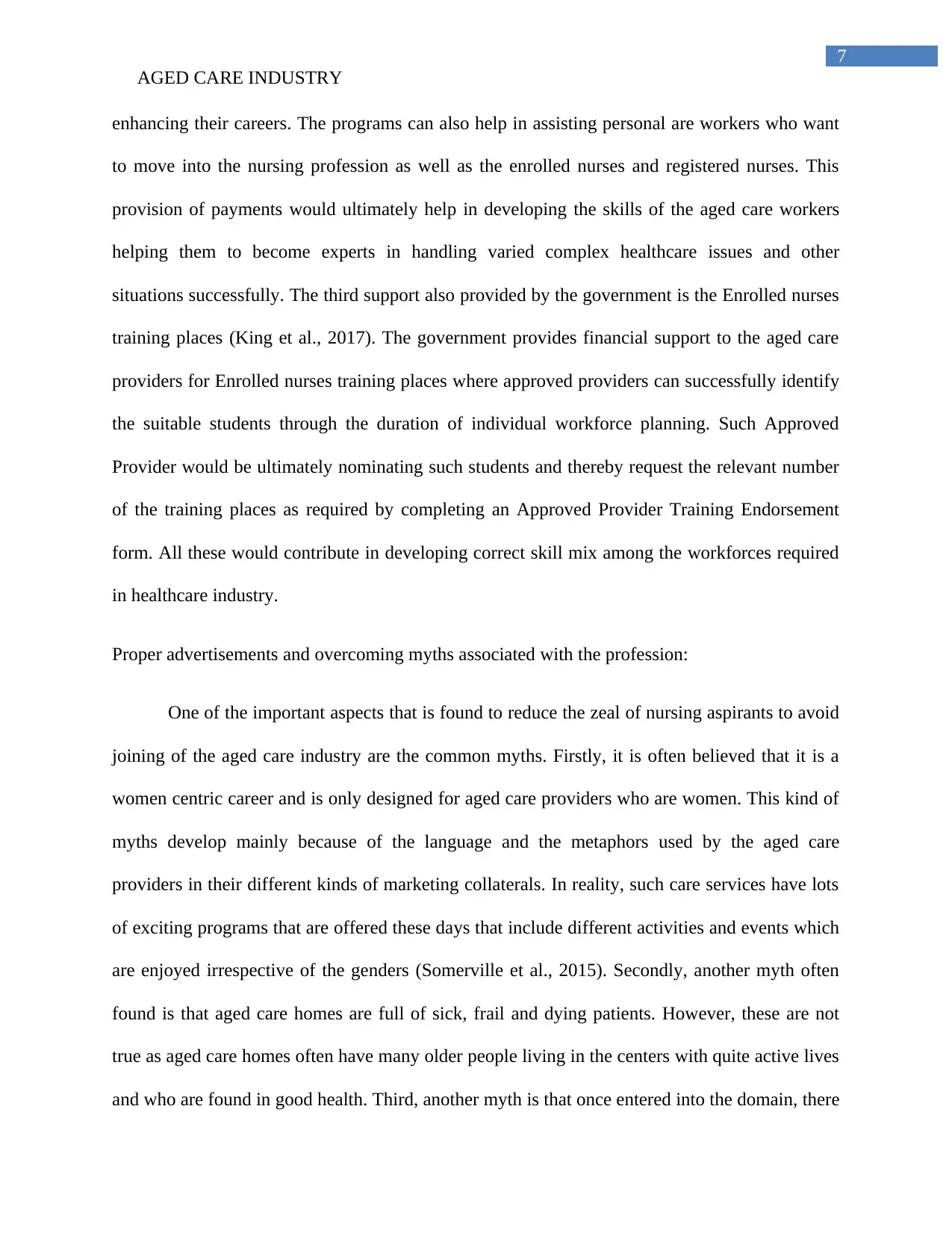
7
AGED CARE INDUSTRY
enhancing their careers. The programs can also help in assisting personal are workers who want
to move into the nursing profession as well as the enrolled nurses and registered nurses. This
provision of payments would ultimately help in developing the skills of the aged care workers
helping them to become experts in handling varied complex healthcare issues and other
situations successfully. The third support also provided by the government is the Enrolled nurses
training places (King et al., 2017). The government provides financial support to the aged care
providers for Enrolled nurses training places where approved providers can successfully identify
the suitable students through the duration of individual workforce planning. Such Approved
Provider would be ultimately nominating such students and thereby request the relevant number
of the training places as required by completing an Approved Provider Training Endorsement
form. All these would contribute in developing correct skill mix among the workforces required
in healthcare industry.
Proper advertisements and overcoming myths associated with the profession:
One of the important aspects that is found to reduce the zeal of nursing aspirants to avoid
joining of the aged care industry are the common myths. Firstly, it is often believed that it is a
women centric career and is only designed for aged care providers who are women. This kind of
myths develop mainly because of the language and the metaphors used by the aged care
providers in their different kinds of marketing collaterals. In reality, such care services have lots
of exciting programs that are offered these days that include different activities and events which
are enjoyed irrespective of the genders (Somerville et al., 2015). Secondly, another myth often
found is that aged care homes are full of sick, frail and dying patients. However, these are not
true as aged care homes often have many older people living in the centers with quite active lives
and who are found in good health. Third, another myth is that once entered into the domain, there
AGED CARE INDUSTRY
enhancing their careers. The programs can also help in assisting personal are workers who want
to move into the nursing profession as well as the enrolled nurses and registered nurses. This
provision of payments would ultimately help in developing the skills of the aged care workers
helping them to become experts in handling varied complex healthcare issues and other
situations successfully. The third support also provided by the government is the Enrolled nurses
training places (King et al., 2017). The government provides financial support to the aged care
providers for Enrolled nurses training places where approved providers can successfully identify
the suitable students through the duration of individual workforce planning. Such Approved
Provider would be ultimately nominating such students and thereby request the relevant number
of the training places as required by completing an Approved Provider Training Endorsement
form. All these would contribute in developing correct skill mix among the workforces required
in healthcare industry.
Proper advertisements and overcoming myths associated with the profession:
One of the important aspects that is found to reduce the zeal of nursing aspirants to avoid
joining of the aged care industry are the common myths. Firstly, it is often believed that it is a
women centric career and is only designed for aged care providers who are women. This kind of
myths develop mainly because of the language and the metaphors used by the aged care
providers in their different kinds of marketing collaterals. In reality, such care services have lots
of exciting programs that are offered these days that include different activities and events which
are enjoyed irrespective of the genders (Somerville et al., 2015). Secondly, another myth often
found is that aged care homes are full of sick, frail and dying patients. However, these are not
true as aged care homes often have many older people living in the centers with quite active lives
and who are found in good health. Third, another myth is that once entered into the domain, there
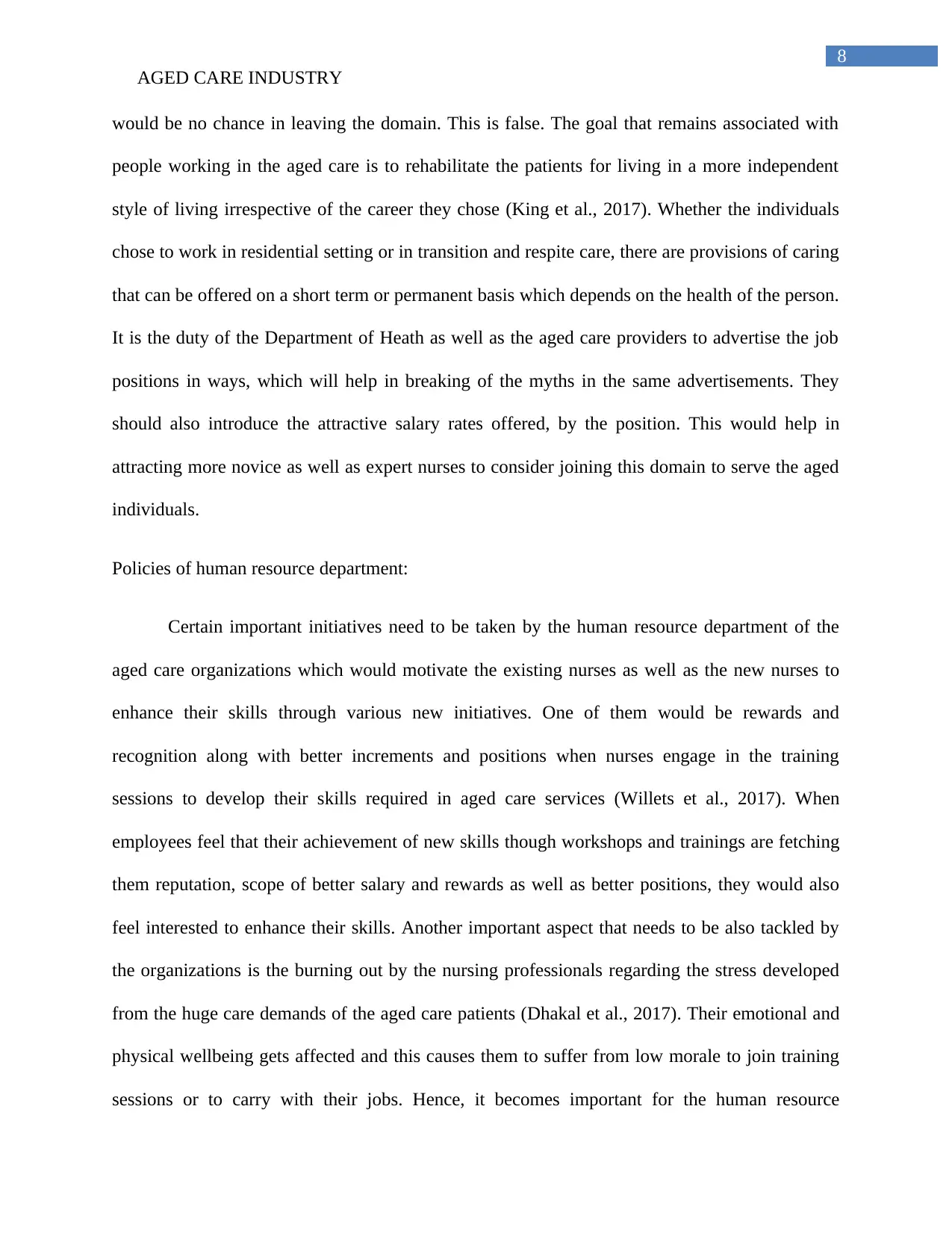
8
AGED CARE INDUSTRY
would be no chance in leaving the domain. This is false. The goal that remains associated with
people working in the aged care is to rehabilitate the patients for living in a more independent
style of living irrespective of the career they chose (King et al., 2017). Whether the individuals
chose to work in residential setting or in transition and respite care, there are provisions of caring
that can be offered on a short term or permanent basis which depends on the health of the person.
It is the duty of the Department of Heath as well as the aged care providers to advertise the job
positions in ways, which will help in breaking of the myths in the same advertisements. They
should also introduce the attractive salary rates offered, by the position. This would help in
attracting more novice as well as expert nurses to consider joining this domain to serve the aged
individuals.
Policies of human resource department:
Certain important initiatives need to be taken by the human resource department of the
aged care organizations which would motivate the existing nurses as well as the new nurses to
enhance their skills through various new initiatives. One of them would be rewards and
recognition along with better increments and positions when nurses engage in the training
sessions to develop their skills required in aged care services (Willets et al., 2017). When
employees feel that their achievement of new skills though workshops and trainings are fetching
them reputation, scope of better salary and rewards as well as better positions, they would also
feel interested to enhance their skills. Another important aspect that needs to be also tackled by
the organizations is the burning out by the nursing professionals regarding the stress developed
from the huge care demands of the aged care patients (Dhakal et al., 2017). Their emotional and
physical wellbeing gets affected and this causes them to suffer from low morale to join training
sessions or to carry with their jobs. Hence, it becomes important for the human resource
AGED CARE INDUSTRY
would be no chance in leaving the domain. This is false. The goal that remains associated with
people working in the aged care is to rehabilitate the patients for living in a more independent
style of living irrespective of the career they chose (King et al., 2017). Whether the individuals
chose to work in residential setting or in transition and respite care, there are provisions of caring
that can be offered on a short term or permanent basis which depends on the health of the person.
It is the duty of the Department of Heath as well as the aged care providers to advertise the job
positions in ways, which will help in breaking of the myths in the same advertisements. They
should also introduce the attractive salary rates offered, by the position. This would help in
attracting more novice as well as expert nurses to consider joining this domain to serve the aged
individuals.
Policies of human resource department:
Certain important initiatives need to be taken by the human resource department of the
aged care organizations which would motivate the existing nurses as well as the new nurses to
enhance their skills through various new initiatives. One of them would be rewards and
recognition along with better increments and positions when nurses engage in the training
sessions to develop their skills required in aged care services (Willets et al., 2017). When
employees feel that their achievement of new skills though workshops and trainings are fetching
them reputation, scope of better salary and rewards as well as better positions, they would also
feel interested to enhance their skills. Another important aspect that needs to be also tackled by
the organizations is the burning out by the nursing professionals regarding the stress developed
from the huge care demands of the aged care patients (Dhakal et al., 2017). Their emotional and
physical wellbeing gets affected and this causes them to suffer from low morale to join training
sessions or to carry with their jobs. Hence, it becomes important for the human resource
⊘ This is a preview!⊘
Do you want full access?
Subscribe today to unlock all pages.

Trusted by 1+ million students worldwide
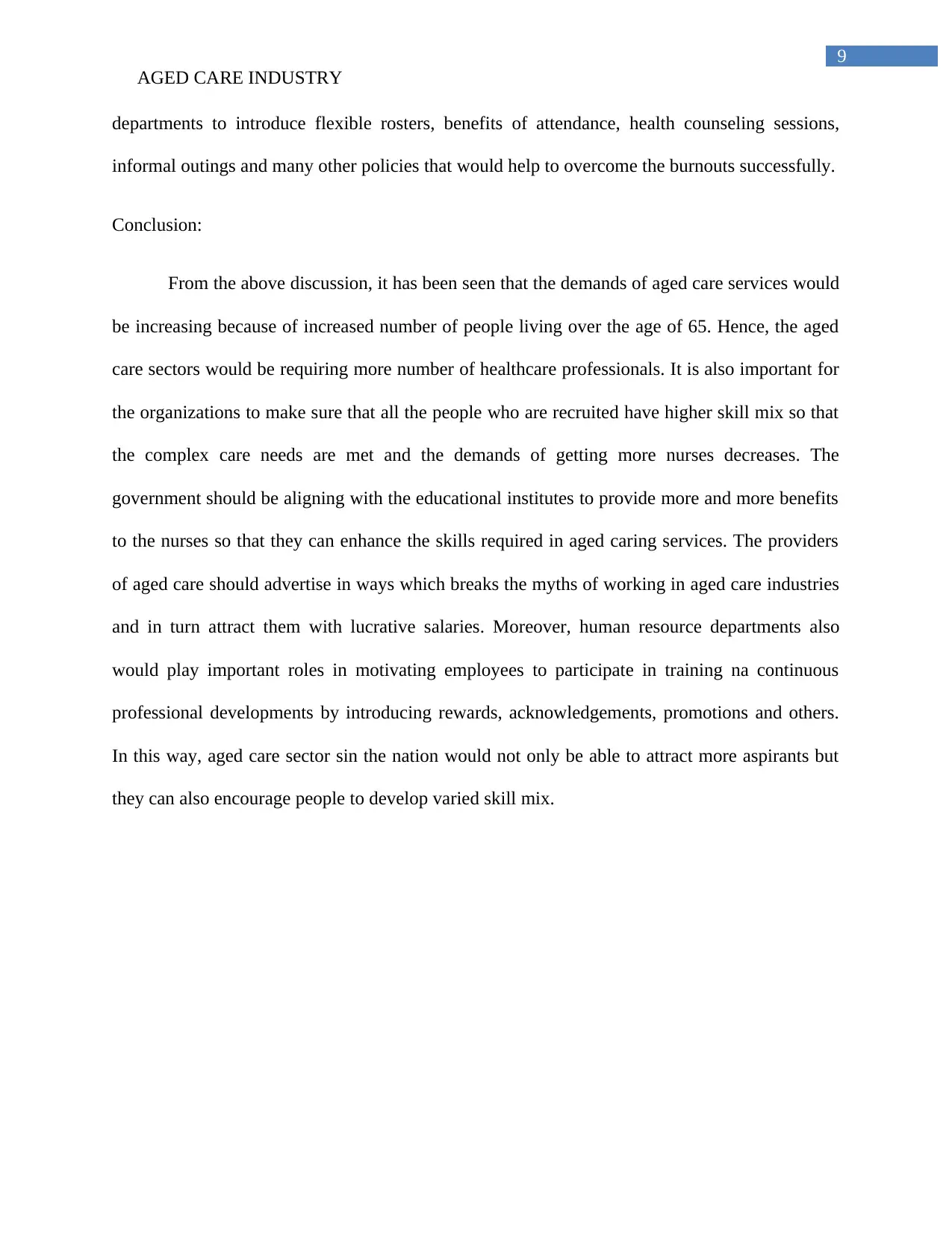
9
AGED CARE INDUSTRY
departments to introduce flexible rosters, benefits of attendance, health counseling sessions,
informal outings and many other policies that would help to overcome the burnouts successfully.
Conclusion:
From the above discussion, it has been seen that the demands of aged care services would
be increasing because of increased number of people living over the age of 65. Hence, the aged
care sectors would be requiring more number of healthcare professionals. It is also important for
the organizations to make sure that all the people who are recruited have higher skill mix so that
the complex care needs are met and the demands of getting more nurses decreases. The
government should be aligning with the educational institutes to provide more and more benefits
to the nurses so that they can enhance the skills required in aged caring services. The providers
of aged care should advertise in ways which breaks the myths of working in aged care industries
and in turn attract them with lucrative salaries. Moreover, human resource departments also
would play important roles in motivating employees to participate in training na continuous
professional developments by introducing rewards, acknowledgements, promotions and others.
In this way, aged care sector sin the nation would not only be able to attract more aspirants but
they can also encourage people to develop varied skill mix.
AGED CARE INDUSTRY
departments to introduce flexible rosters, benefits of attendance, health counseling sessions,
informal outings and many other policies that would help to overcome the burnouts successfully.
Conclusion:
From the above discussion, it has been seen that the demands of aged care services would
be increasing because of increased number of people living over the age of 65. Hence, the aged
care sectors would be requiring more number of healthcare professionals. It is also important for
the organizations to make sure that all the people who are recruited have higher skill mix so that
the complex care needs are met and the demands of getting more nurses decreases. The
government should be aligning with the educational institutes to provide more and more benefits
to the nurses so that they can enhance the skills required in aged caring services. The providers
of aged care should advertise in ways which breaks the myths of working in aged care industries
and in turn attract them with lucrative salaries. Moreover, human resource departments also
would play important roles in motivating employees to participate in training na continuous
professional developments by introducing rewards, acknowledgements, promotions and others.
In this way, aged care sector sin the nation would not only be able to attract more aspirants but
they can also encourage people to develop varied skill mix.
Paraphrase This Document
Need a fresh take? Get an instant paraphrase of this document with our AI Paraphraser
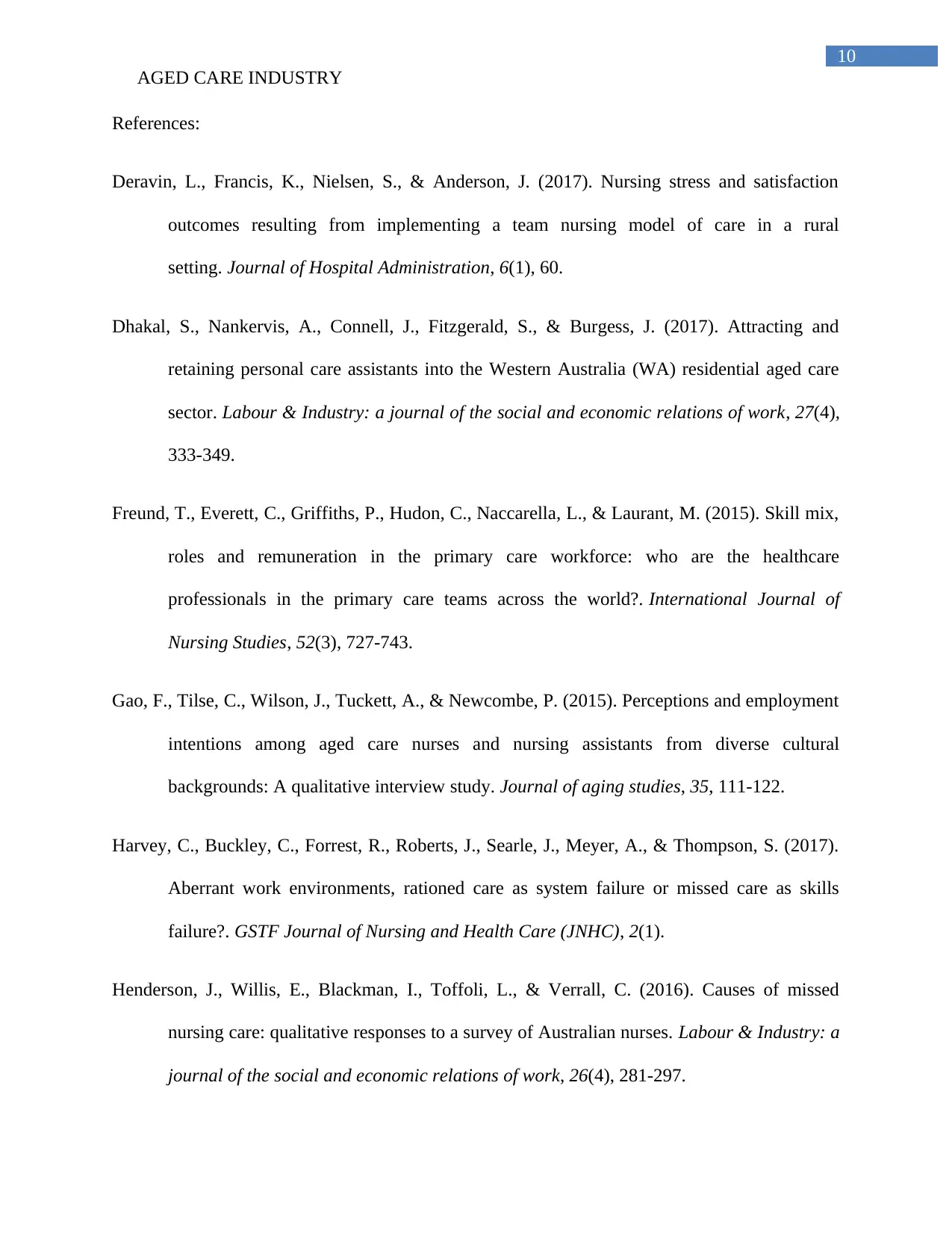
10
AGED CARE INDUSTRY
References:
Deravin, L., Francis, K., Nielsen, S., & Anderson, J. (2017). Nursing stress and satisfaction
outcomes resulting from implementing a team nursing model of care in a rural
setting. Journal of Hospital Administration, 6(1), 60.
Dhakal, S., Nankervis, A., Connell, J., Fitzgerald, S., & Burgess, J. (2017). Attracting and
retaining personal care assistants into the Western Australia (WA) residential aged care
sector. Labour & Industry: a journal of the social and economic relations of work, 27(4),
333-349.
Freund, T., Everett, C., Griffiths, P., Hudon, C., Naccarella, L., & Laurant, M. (2015). Skill mix,
roles and remuneration in the primary care workforce: who are the healthcare
professionals in the primary care teams across the world?. International Journal of
Nursing Studies, 52(3), 727-743.
Gao, F., Tilse, C., Wilson, J., Tuckett, A., & Newcombe, P. (2015). Perceptions and employment
intentions among aged care nurses and nursing assistants from diverse cultural
backgrounds: A qualitative interview study. Journal of aging studies, 35, 111-122.
Harvey, C., Buckley, C., Forrest, R., Roberts, J., Searle, J., Meyer, A., & Thompson, S. (2017).
Aberrant work environments, rationed care as system failure or missed care as skills
failure?. GSTF Journal of Nursing and Health Care (JNHC), 2(1).
Henderson, J., Willis, E., Blackman, I., Toffoli, L., & Verrall, C. (2016). Causes of missed
nursing care: qualitative responses to a survey of Australian nurses. Labour & Industry: a
journal of the social and economic relations of work, 26(4), 281-297.
AGED CARE INDUSTRY
References:
Deravin, L., Francis, K., Nielsen, S., & Anderson, J. (2017). Nursing stress and satisfaction
outcomes resulting from implementing a team nursing model of care in a rural
setting. Journal of Hospital Administration, 6(1), 60.
Dhakal, S., Nankervis, A., Connell, J., Fitzgerald, S., & Burgess, J. (2017). Attracting and
retaining personal care assistants into the Western Australia (WA) residential aged care
sector. Labour & Industry: a journal of the social and economic relations of work, 27(4),
333-349.
Freund, T., Everett, C., Griffiths, P., Hudon, C., Naccarella, L., & Laurant, M. (2015). Skill mix,
roles and remuneration in the primary care workforce: who are the healthcare
professionals in the primary care teams across the world?. International Journal of
Nursing Studies, 52(3), 727-743.
Gao, F., Tilse, C., Wilson, J., Tuckett, A., & Newcombe, P. (2015). Perceptions and employment
intentions among aged care nurses and nursing assistants from diverse cultural
backgrounds: A qualitative interview study. Journal of aging studies, 35, 111-122.
Harvey, C., Buckley, C., Forrest, R., Roberts, J., Searle, J., Meyer, A., & Thompson, S. (2017).
Aberrant work environments, rationed care as system failure or missed care as skills
failure?. GSTF Journal of Nursing and Health Care (JNHC), 2(1).
Henderson, J., Willis, E., Blackman, I., Toffoli, L., & Verrall, C. (2016). Causes of missed
nursing care: qualitative responses to a survey of Australian nurses. Labour & Industry: a
journal of the social and economic relations of work, 26(4), 281-297.
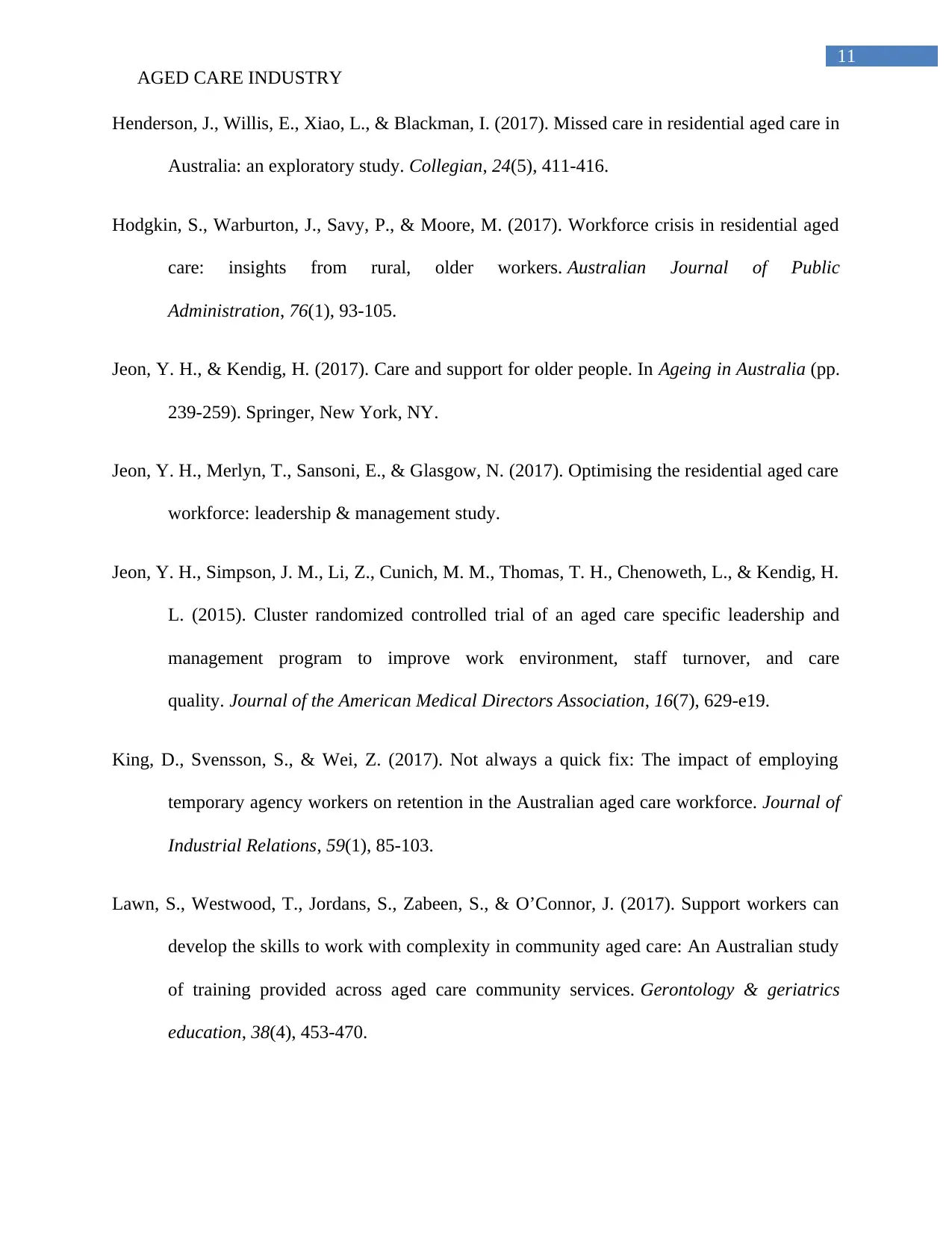
11
AGED CARE INDUSTRY
Henderson, J., Willis, E., Xiao, L., & Blackman, I. (2017). Missed care in residential aged care in
Australia: an exploratory study. Collegian, 24(5), 411-416.
Hodgkin, S., Warburton, J., Savy, P., & Moore, M. (2017). Workforce crisis in residential aged
care: insights from rural, older workers. Australian Journal of Public
Administration, 76(1), 93-105.
Jeon, Y. H., & Kendig, H. (2017). Care and support for older people. In Ageing in Australia (pp.
239-259). Springer, New York, NY.
Jeon, Y. H., Merlyn, T., Sansoni, E., & Glasgow, N. (2017). Optimising the residential aged care
workforce: leadership & management study.
Jeon, Y. H., Simpson, J. M., Li, Z., Cunich, M. M., Thomas, T. H., Chenoweth, L., & Kendig, H.
L. (2015). Cluster randomized controlled trial of an aged care specific leadership and
management program to improve work environment, staff turnover, and care
quality. Journal of the American Medical Directors Association, 16(7), 629-e19.
King, D., Svensson, S., & Wei, Z. (2017). Not always a quick fix: The impact of employing
temporary agency workers on retention in the Australian aged care workforce. Journal of
Industrial Relations, 59(1), 85-103.
Lawn, S., Westwood, T., Jordans, S., Zabeen, S., & O’Connor, J. (2017). Support workers can
develop the skills to work with complexity in community aged care: An Australian study
of training provided across aged care community services. Gerontology & geriatrics
education, 38(4), 453-470.
AGED CARE INDUSTRY
Henderson, J., Willis, E., Xiao, L., & Blackman, I. (2017). Missed care in residential aged care in
Australia: an exploratory study. Collegian, 24(5), 411-416.
Hodgkin, S., Warburton, J., Savy, P., & Moore, M. (2017). Workforce crisis in residential aged
care: insights from rural, older workers. Australian Journal of Public
Administration, 76(1), 93-105.
Jeon, Y. H., & Kendig, H. (2017). Care and support for older people. In Ageing in Australia (pp.
239-259). Springer, New York, NY.
Jeon, Y. H., Merlyn, T., Sansoni, E., & Glasgow, N. (2017). Optimising the residential aged care
workforce: leadership & management study.
Jeon, Y. H., Simpson, J. M., Li, Z., Cunich, M. M., Thomas, T. H., Chenoweth, L., & Kendig, H.
L. (2015). Cluster randomized controlled trial of an aged care specific leadership and
management program to improve work environment, staff turnover, and care
quality. Journal of the American Medical Directors Association, 16(7), 629-e19.
King, D., Svensson, S., & Wei, Z. (2017). Not always a quick fix: The impact of employing
temporary agency workers on retention in the Australian aged care workforce. Journal of
Industrial Relations, 59(1), 85-103.
Lawn, S., Westwood, T., Jordans, S., Zabeen, S., & O’Connor, J. (2017). Support workers can
develop the skills to work with complexity in community aged care: An Australian study
of training provided across aged care community services. Gerontology & geriatrics
education, 38(4), 453-470.
⊘ This is a preview!⊘
Do you want full access?
Subscribe today to unlock all pages.

Trusted by 1+ million students worldwide
1 out of 14
Related Documents
Your All-in-One AI-Powered Toolkit for Academic Success.
+13062052269
info@desklib.com
Available 24*7 on WhatsApp / Email
![[object Object]](/_next/static/media/star-bottom.7253800d.svg)
Unlock your academic potential
Copyright © 2020–2025 A2Z Services. All Rights Reserved. Developed and managed by ZUCOL.





